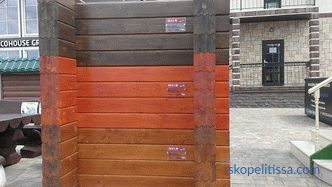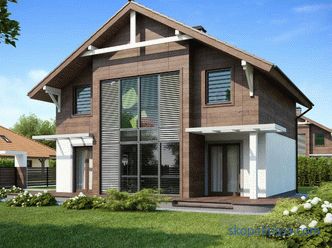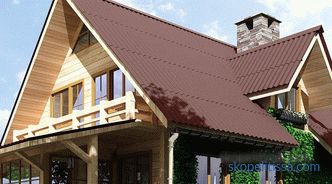A flowering culture with expressive fragrant flowers, decorative almonds, take root very well in the climatic conditions of the middle zone. The article describes the plant and tells about its history and distribution. You will get acquainted with popular varieties, find out which place for planting is considered optimal and what rules for plant care exist.

General description
All modern ornamental almond varieties, small trees or shrubs come from East Asia; in North Korea and China, and today the plant is found in the wild. This closest relative of the plum, quince and wild rose during the flowering period is covered with spectacular flowers in a predominantly pink range, acquiring an unusually picturesque view. Thanks to this feature, almond has become one of the most sought-after garden plants around the world; The almond tree can be described in the following facts:
-
Distribution . The plant came to Europe a couple of centuries ago, but in Russia it was grown only in the 20th century. Today, almonds can be seen both in Europe and in Central Asia, and in America.
-
Variety . There are many varieties of this elegant plant. Depending on the variety, it can look like a large bush two or three meters tall or a tree with strong branching, reaching five meters in height.

-
Appearance . During flowering (which lasts 2-3 weeks), the branches are covered with numerous pink flowers; simple or double flowers create the impression of a lush cloud and give the plant an extraordinary decorative effect. After flowering, almonds retain their appeal due to the compact and spherical shape of the crown; fruits of an ornamental plant are inedible.
-
Almond in landscape design found the widest distribution. It is planted as a solitary plant or is made the center of the composition; sometimes planted in a hedge.
-
Properties . Almond tree, despite its origin, is a very unpretentious culture. In the wild, it can be found in the Caucasus and Western Siberia, in the European part of Russia - in the summer and garden plots. The shrub has a fairly high frost resistance (up to 20-25 ° C frost) and drought resistance (which nevertheless should not be overestimated).
-
Decorative enhancement . To bloom was spectacular, the branches must be cut each year; otherwise they will stretch.
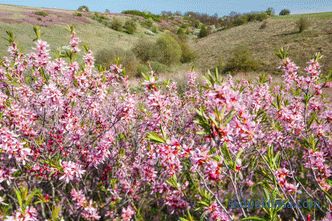
Choice of variety
Although, compared to other shrubs , almonds do not require special care, when choosing a variety, it is necessary to assess the climatic conditions of the garden (frequency of rain and the quality of the soil). If the terrain where the plot is located is too dry, the tree may have difficulty adapting. The following varieties of almond can be cultivated in the middle lane:
-
Decorative steppe . Distributed and other names of this plant - almond or low almond. The bush reaches one and a half meters in height and blooms for a short period - you can enjoy the white-pink cloud for no more than 7-10 days. There are two forms of plants, one with white flowers. A pleasant feature of the plant is fragrant flowers and edible fruits.
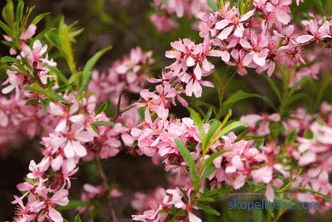
On our site you can find contacts of construction companies that offer landscaping services. You can directly communicate with representatives by visiting the low-rise country exhibition.
-
Cultivar varieties . Among the popular varieties suitable for breeding in the temperate zone with cold winters are Pink Flamingo with an early flowering period, Pink Mist, Anyuta, Dream and drought-resistant White Sail. For all varieties it is important to choose a landing site. If you want to maximize the flowering, the place for the plant is selected in the penumbra. If the main thing for you is the splendor of flowering, plant a plant in a sunny area.
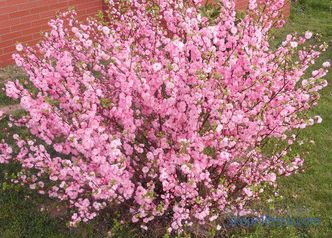
-
Three-lobed Almond (Prúnus tríloba). One of the hybrid varieties, the second official name of which is three-blade luizeania, and the popular is sakura near Moscow (option: Japanese cherry or Chinese terry plum). The grade received the name because of a characteristic (three-blade) form of leaves. Almond tree grows particularly well in sunny areas, but does not like strong wind. Flowers bloom in mid-May, they can have different color saturation, from pale pink to deep crimson.
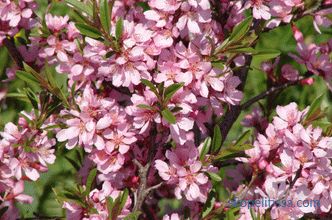
-
Georgian Almonds .The bush resembles a steppe variety in appearance, but has somewhat larger leaves; the area of distribution is the wooded slopes of the Caucasus Mountains. The plant reaches a height of 1-1.5 m and has a developed root system. During flowering branches are covered with bright pink color. The fruits ripen by mid-September and only on plants that have reached the age of seven to nine years. The variety is valued among amateur gardeners for its particular simplicity: resistance to the vagaries of the weather, diseases and pests.
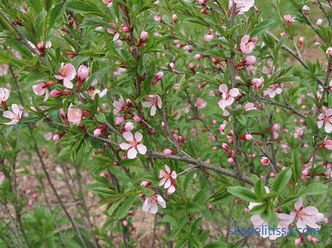
-
Almond Petunnikova . This type of shrub comes from the stony elevations of Central Asia, which determined its appearance: Almond bushes with grayish bark and long leaves rarely reach a height of 1 m and a crown diameter of 0.8-1 m. At home in the wild, the plant forms dense almond In Russian cottages, you can often see individual plants. The particular charm of the shrub during flowering is given by single flowers of a rich pink tone; fruits appear in the sixth year.
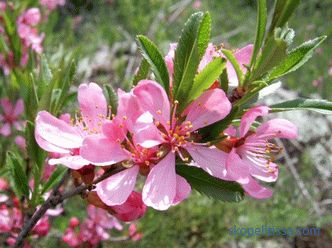
On our website you can find contacts of construction companies that offer construction services of small architectural forms. You can directly communicate with representatives by visiting the low-rise country exhibition.
-
Almond Ledebourg . Homeland varieties of Ledebour - Altai foothills and plains, where you can still find thickets of almond bushes in the wild. One of the most popular, despite the dwarfism (1 m), varieties among gardeners. Its value lies in the early flowering and general simplicity. Variety blooms in early May, bright pink splendor adorns the surrounding landscape for two to three weeks; begins to bear fruit after 9-10 years, but it is not necessary to expect special crops from it. Attention is paid to a variety of shrubs, Fire Hill, with large, up to three centimeters in diameter, flowers of rich pink color.
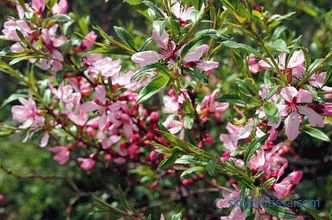
-
Wimura Snow . A common hybrid variety, large terry inflorescences which during flowering change color from the original pink to cream.
-
Ruslana . A three-lobed almond hybrid, also known for color change. Initially, its flowers are painted beige, but over time they become snow-white.
On the characteristics of the variety Louisiana in the following video:
Planting
Gardener who decided to decorate his plot almond tree, you must provide the following conditions for well-being of the plant:
-
Illumination . All varieties love the sun and the air. If you can not provide a permanent place in the sun, plant a plant so that the shadow fell on him no more than 3-4 hours a day.
-
Wind . To make the tree grow well and make you happy in full color, take care of protection from the prevailing winds in the area; it may be a fence, slope or construction.
-
Soil . The best option for almonds is sandy, and even rocky soil with good drainage capacity. If your site is clayey, it will have to lime.
-
Water stagnation . The place where the soil periodically heats up is not suitable for the root system of almonds - it can die.
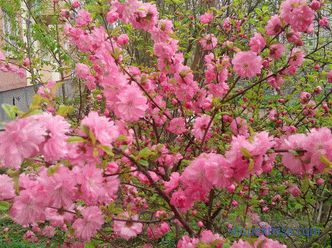
It can be interesting! In the article on the following link read about the decorative garden crane.
Planting almonds can be done with seedlings or seeds, and is determined by the plant variety. More common planting saplings; this way is attractive with fast results: you can admire the flowering in the second year. A gardener who decides to plant several plants should take into account the following rules:
-
Planting time . Decorative almonds are usually planted in the fall, always fertilizing the soil. This will help the seedlings to adapt to the gradual decrease in temperature and to endure winter without problems.
-
The importance of cross-pollination . If you do not take care of the conditions for this important process, the almonds will not bloom. To pollination took place, trees planted close to each other; the optimal distance between seedlings is at least 3 m. At the bottom of each pit, a cushion of rubble and sand is arranged.
-
Watering . Since the plant is drought tolerant, in most cases one watering per week is sufficient.
About the distinction of almond varieties in the following video:
Features of agricultural machinery
Almonds belonging to a kind of ornamental plum, well acclimatized on moderately fertile soils, if it is planted in a sunny place with desirable drainage. In order for the plant to develop well and bloom, additional care is required, which consists (in addition to watering, fertilizing and loosening) in the following actions:
-
Crop . The procedure has two objectives: it forms the crown and is the prevention of disease. If pruning is not carried out, the decorativeness of the plant is reduced, and you will not wait for a lush color. Sanitary pruning helps to get rid of potentially dangerous dry and mold-damaged branches. Decorative pruning cuts the crown, removing interfering and growing inside branches. For recovery, after flowering, the branches are shortened by 2/3 of the length; Such an operation stimulates the growth of new, healthy shoots.

-
Wintering . During cold winters, frost can damage the kidneys, and excess snow will damage the base of the trunk. To protect young almonds from problems, the base is covered with straw, and the branches are carefully wrapped with a covering material (for example, lutrasil).
-
Inspection as prevention of diseases and pest control . Most often, almonds can become a victim of aphids sucking juices, or caterpillars, in a short time leaving branches without leaves. The larvae of the May beetle, which are capable of permanently ruining the root system, are also dangerous. A bush disease can cause a fungus, virus, or adverse environmental conditions. There are a wide range of chemicals for problem solving, and natural remedies are sometimes effective (for example, ladybirds gladly include aphids in their diets).
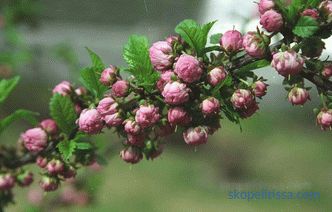
It might be interesting! In the article follow this link read about the stealth garage of James Bond.
Conclusion
Decorative almonds will give you pleasant moments of admiring with delicate pink blossoms; the plant is attractive by a combination of its properties: it is unpretentious, grows quickly and begins to bloom, it is easy to fit into any landscape. Powerful and extensive root system allows you to use it as a soil-protective plants (especially on the slopes). Popular varieties include Gessler's almond and belotsvetkovy, as well as some hybrid varieties.
Rate this article, we tried for you


